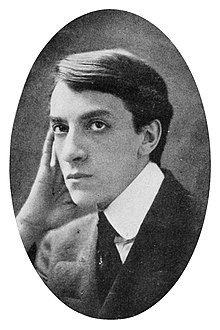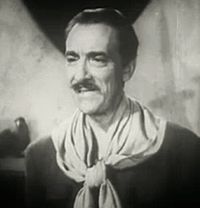| This article needs additional citations for verification. Please help improve this article by adding citations to reliable sources. Unsourced material may be challenged and removed. Find sources: "Pedro de Cordoba" – news · newspapers · books · scholar · JSTOR (July 2015) (Learn how and when to remove this message) |
| Pedro de Cordoba | |
|---|---|
 Cordoba, c. 1909 Cordoba, c. 1909 | |
| Born | Pietro de Cordoba (1881-09-28)September 28, 1881 New York City, US |
| Died | September 16, 1950(1950-09-16) (aged 68) Sunland, California, US |
| Resting place | Holy Cross Cemetery, Culver City |
| Occupation | Actor |
| Years active | 1901–1951 |
| Spouses |
(m. 1928) |
Pedro de Cordoba (September 28, 1881 – September 16, 1950) was an American actor.
Biography

De Cordoba was born in New York City to parents who were French and Cuban in origin. He was a classically trained theatre actor who confessed he did not enjoy appearing in silent films nearly as much as he liked working on stage, but his career during the silent film era was extensive.
In 1913 he was a member of the resident summer stock cast at Elitch Theatre in Denver, Colorado.
His first film was Cecil B. DeMille's version of Carmen (1915), and he soon became a regular leading man in Hollywood. His Broadway career cast him with such stage actresses as Jane Cowl and Katharine Cornell.
In the sound era, his deeply resonant speaking voice made him perfectly suited to talking pictures and was active as a character actor in Hollywood, from the mid-1930s through to the end of his life. He was most often cast as aristocratic, or clerical characters of Hispanic origin, as in The Keys of the Kingdom (1944), because of his last name as well as his royal bearing. On rare occasions, he would be cast in the role of a villain. His "living skeleton" sideshow character hides fugitive Robert Cummings (and Priscilla Lane) in his carnival wagon overnight in the Alfred Hitchcock film Saboteur (1942).
He was a devout Catholic and served for a time as president of the Catholic Actors Guild of America. The last film in which he appeared, a political drama set in an unnamed South American dictatorship, Crisis (1950), was released shortly after his death.
Selected filmography



Radio appearances
| Year | Program | Episode/source |
|---|---|---|
| 1937 | Lux Radio Theatre | Madame Butterfly |
| 1946 | Hollywood Star Time | The Song of Bernadette |
References
- "Pedro de Cordoba (1913) – Historic Elitch Theatre". hetden.org. Retrieved 2024-01-19.
- "Pedro de Cordoba (1913) – Historic Elitch Theatre". historicelitchtheatre.org. Retrieved 2024-09-08.
- ^ "Frankie and Johnnie Credits". Movies & TV Dept. The New York Times. 2014. Archived from the original on 2014-11-29.
- "Those Were the Days". Nostalgia Digest. 41 (2): 32–41. Spring 2015.
External links
- Pedro de Cordoba at IMDb

- Pedro de Cordoba at the Internet Broadway Database

- Pedro de Cordoba at AllMovie - entry #1
- Pedro de Cordoba at AllMovie - entry #2 (All Movie has disjointed entries)
- Pedro de Cordoba at Find a Grave
- left to right: Gladys Hulette, Lionel Barrymore, Pedro de Cordoba in Enemies of Women (1923)
- nytimes.com – New York Times > Movies > Pedro de Cordoba
- nytimes.com – News clippings
- 1881 births
- 1950 deaths
- 20th-century American male actors
- 20th-century Roman Catholics
- American male film actors
- American male radio actors
- American male silent film actors
- American male stage actors
- American entertainers of Cuban descent
- American people of French descent
- American Roman Catholics
- Burials at Holy Cross Cemetery, Culver City
- Catholics from New York (state)
- Hispanic and Latino American male actors
- Male actors from New York City